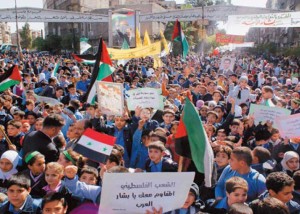
In a move unthinkable five weeks ago in Syria,protesters took to the streets demanding freedom and an end to the ruling 41-year Assad dynasty. Last week,the Syrian government finally approved a bill to lift the state of half century old emergency law,a major demand of pro-democracy protesters,while adopting a new legislation that requires Syrians to seek permission in order to demonstrate.
However,the lifting of the emergency law failed to pacify the protesters as the unrest sweeping the Middle East seems to be reaching critical mass,especially with the help of social network sites. On 22 April on the so called “dignity Friday”,the country experienced its biggest and bloodiest day in the current series of protests as tens of thousands took to the streets. Protests occurred in the capital,Damascus,and in at least ten other cities in the country.
Hundreds of protesters in central Damascus were dispersed,but thousands congregated in towns ringing the capital. According to the protesters’own reports,at least 70 people were killed nationwide when security opened fire on the demonstrators. Immediate verification was difficult because Syria had expelled almost all members of the international media from the country although The New York Times reported the next day that 104 had been killed. Later reports indicated that 112 had been killed that day.
The rising level of violence,with more than 300 civilians killed across Syria since the unrest broke out in the city of Deraa,has brought calls from the Watchdog group Human Rights Watch for a UN inquiry. After Friday’s carnage,it is no longer enough to condemn the violence,”Joe Stork,deputy Middle East Human Rights Watch director said in a statement. “Faced with the Syrian authorities’‘shoot to kill’strategy,the international community needs to impose sanctions on those ordering the shooting of protesters.”
UN Secretary-General Ban Ki-moon has called for “transparent investigation into the killings”. Many Western leaders,including U.S. President Barack Obama,have condemned Syria’s harsh tactics to quell dissident.
Two doctors told Human Rights Watch that they each treated four wounded protesters in Harasta,near Damascus. They said it was impossible to bring the injured into the hospital because it was surrounded by the security forces,barring injured from medical care.
On Sunday,state-run news agency SANA reported that 286 police officers have been wounded since the uprising began. It did not give any further details. Assad has blamed most of the unrest on a “foreign conspiracy”and armed gang trying to sow sectarian conflict. Fears of sectarianism are strong in Syria with the dangers of fractured societies so apparent in neighboring Iraq and Lebanon.
Last week,in a speech before parliament,Syrian President Bashar al-Assad repeated his criticism of satellite television stations,accusing them of being responsible for the current protests in Syria. He made these same accusations 7 times in less than an hour.
Some critics have been casting him in the same mould as his father Hafez al Assad,who crushed the last major domestic uprising with a massacre in Hama in 1982 where more than 40,000 died.
But possible cracks could be emerging from within. Two legislators and a religious leader from the southern province of Daraa — where the uprising began — resigned Saturday in revulsion over the killings. The member from Daara,the region that saw worst of the killing with at least 50 shot dead,simply said that he wouldn’t sit in the parliament when he cannot protect his own people.
Another walkout came Sunday when a member of the Daraa provincial council,Bassam al-Zamel,left his post to denounce the violence.
Syrian blogs have also made talks about cracks emerging within the army and are soon expecting more.
Meanwhile the protests seem to be organized more than any other uprising before it as the Syrian Revolution 2011 page on Facebook,which has attracted more than 140,000 followers,has become a crucial point. Run predominantly by expatriate Syrians,it has disseminated tips for holding a successful demonstration and promoting a show of national unity with the slogan “One heart. One hand. One goal”. The distressing,graphic video footage emerging from across Syria with children being shot on the head and tortured heavily are casting Assad’s rule in a different scope. A scope unknown to many people until now due to the tightly-controlled Arab country were even press is state owned.
Political life in Syria has long been stagnant,dominated by the ruling Baath party since 1963. The power is concentrated in the hands of the president where no other political parties are licensed. Syria was under Emergency Law since 1962,effectively suspending most constitutional protections for citizens. Syrian governments have justified the state of emergency by pointing to the fact that Syria is in a state of war with Israel. Syrian citizens approve the President in a referendum. Syria does not hold multi-party elections for its legislature.
Hamed EL Mekdad ,a 27-year-old doctor from Daraa told PostNews.gr:“ I am a member of the Baath party 15 years now,not because I want to,but under the Talae system,all school students are obliged to join a Baath Party Youth organization. This law still exists along with the emergency law which leaves security forces without accountability.”
Inspired by the Middle east uprisings,it all started when a group of teenagers were caught writing “downfall the regime”,a rallying cry of the Tunisian and Egyptian Revolution,were detained and tortured.
The supposedly immune to domino effect,Syria,is now beginning to wobble… Could its old regime soon fall? “This is a race to the bottom and there is no going back.” Hamed says. “If you look up liberty in a thesaurus,birthright is listed as one of the first synonyms. Soon we will get what they owe us back”.
Ρεπορτάζ- Επιμέλεια:J.J.